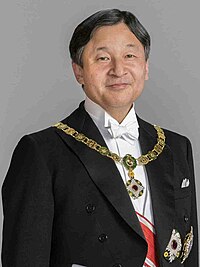
Back Keiser van Japan Afrikaans إمبراطور اليابان Arabic امبراطور اليابان ARZ জাপানৰ সম্ৰাট Assamese Emperador de Xapón AST Yaponiya imperatoru Azerbaijani Emperador kan Hapon BCL Імператар Японіі Byelorussian Император на Япония Bulgarian Kaisar Japang BJN
| Emperor of Japan | |
|---|---|
| 天皇 | |
Imperial | |
 | |
| Incumbent | |
 | |
| Naruhito since 1 May 2019 | |
| Details | |
| Style | His Imperial Majesty or His Majesty |
| Heir presumptive | Fumihito |
| First monarch | Emperor Jimmu (legendary) |
| Formation | 11 February 660 BC; 2,684 years ago[1] |
| Residence | Tokyo Imperial Palace (official residence) |
| Appointer | Hereditary |
| Website | www |
The Emperor of Japan[2] is the head of state of Japan, The monarch is the symbol of the Japanese nation and the unity of its people.[3]
In the Japanese constitutional monarchy, the emperor does not have any political power.[4] In world politics, he is the only current emperor.
The current emperor is his Majesty emperor Naruhito. He has been on the Chrysanthemum Throne since his father Akihito abdicated in 2019.
The amount of power belonging to the emperor of Japan has changed a lot throughout Japanese history. The Emperor of Japan has sometimes been a cleric with mostly symbolic powers and sometimes an actual ruler. Some believe that the emperor is descended from gods.
Since the mid-1800s, the Imperial Palace has been located on the former site of Edo Castle (江戸城)in the heart of Tokyo. Earlier emperors lived in Kyoto for nearly eleven centuries.
- ↑ "Jimmu", Japan: An Illustrated Encyclopedia (1993), Kodansha, ISBN 978-4069310980.
- ↑ Nussbaum, Louis-Frédéric. (2005). "Tennō" in Japan Encyclopedia, p. 960.
- ↑ Nussbaum, "Emperors" at p. 176.
- ↑ Many countries that now have democracy decide to keep their historical king or emperor as a way to celebrate their history and culture.